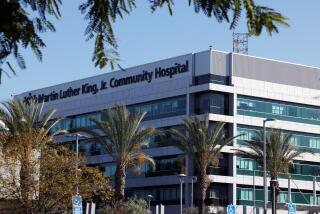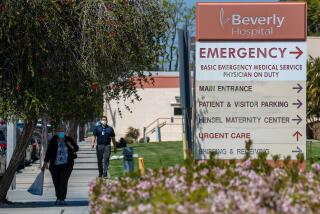Rural Hospitals Turn to Innovation to Survive as Hundreds Close Doors : Medicine: The rebirth of medical care in a rural North Carolina area is the result of an alliance of hospitals with will to live.
- Share via
BURNSVILLE, N.C. — Worse than the pain, Darrell Mitchell recalls, was the fear of how badly he was hurt.
A 30-foot fall from a cherry tree had shattered his left arm. Bone poked from his elbow. He was covered with blood.
“It was only when I made it to Burnsville that I knew I was going to be OK,” Mitchell said.
“Burnsville” is the Yancey County Medical Center--a primary care clinic born of a failed hospital, the former Burnsville Community. It’s where Mitchell was bandaged and sedated before being rushed to Memorial Mission Medical Center, 35 miles away in Asheville, where an orthopedic team set nine fractures in his hand and arm.
“It would have been bad if there was nothing in Burnsville,” he said. “It didn’t relieve the pain, but it relieved me to know I was in their care and everything was going to be all right.”
Mitchell’s path from orchard to operating suite provides a map for health care reform that is moved by economics and modest government programs rather than by the proposals for sweeping change that foundered in Congress.
The rebirth of medical care in Burnsville is the result of a health care alliance, similar to what President Clinton’s original plan would have required. In this case it was formed willingly, by three hospitals seeking survival.
“These alliances and partnerships are developing in response to market forces,” said Jim Bernstein, head of North Carolina’s Office of Rural Health. “We have health reform under way without health reform legislation.”
Burnsville also provides a glimpse of the kinds of missteps and excesses that contributed to the nation’s health care crisis.
Because of such misjudgments, this little town in the Blue Ridge foothills was virtually without medical care for 18 months after its 16-bed hospital closed, awash in years of red ink.
Key to the problem was the reluctance, typical in small towns, to sacrifice a struggling local hospital so another might grow stronger and thrive.
“If a community is realistic and says this hospital isn’t working and looks at alternatives, it’s going to stand it in good stead. If it doesn’t change, the community suffers,” said John Supplitt, director of the American Hospital Assn.’s section for small or rural hospitals.
Burnsville’s stubbornness might be hard for urbanites to understand. Only 20 miles to the east is the 42-bed Spruce Pine Community Hospital; Asheville’s Memorial Mission Hospital, a 418-bed regional medical center, is 45 minutes to the west.
Ambulance and helicopter can get a critically ill rural patient to help in the time it takes a city ambulance to fight through heavy traffic.
But the fates of rural hospitals are always tangled in civic pride and economic hard choices. In small towns, hospitals are major employers. They help attract doctors as well as other new residents and businesses.
“It’s unfortunate we’ve built everything around the hospital being the focal point of health care,” said Bernstein. “Communities pour money into the hospital and, when it can’t survive anymore, you pull the rug out from under them.”
Many towns have suffered Burnsville’s fate. The hospital association says 389 rural hospitals closed from 1980 through 1992. The rate is accelerating: Two-thirds of those closings came after 1987.
Many were built under the Hall-Burton Act, a federal effort to seed the heartland with hospitals after World War II. The program moved at such feverish speed that Sears, Roebuck & Co. sold prefabricated hospital kits.
But by the 1980s, demographics and rapid medical changes were making those hospitals obsolete.
Younger generations moved away from their rural roots, leaving behind lower-paying Medicare patients. Unable to afford costly CAT and MRI scanners, cardiac labs and state-of-the-art surgical suites, rural hospitals began losing patients to larger regional hospitals for even the most basic procedures.
“We can cover 85% of what you go to the hospital for, but we’re always fighting that notion that bigger is better,” said Keith Holtsclaw, vice president of Spruce Pine Community Hospital.
Spruce Pine and Yancey County Hospital opened in the mid-1950s. By 1977, both needed renovation. At the urging of consultants and government officials, the two merged as the Blue Ridge Hospital System Inc.
The new entity spent $3 million to renovate and expand. Yancey County Hospital became Burnsville Community Hospital, an acute-care facility with 16 beds, skilled nursing and a 24-hour emergency room.
While that meant a shiny new facility for the citizens of Burnsville, it duplicated what was down the road in Spruce Pine.
Then came cuts in Medicare payments, which cover 70% of both hospitals’ patient population. The two hospitals ran up a $4.2-million deficit. Burnsville lost $750,000 annually on its underused emergency room alone.
“There was no favorable bottom line in keeping Burnsville,” said Charles Aldridge, Spruce Pine president, who wrote checks to cover expenses, then tucked them into a desk drawer awaiting cash to cover them.
“We were cannibalizing our assets to keep the operations working,” he said.
Despite the losses, local politics created a tug of war: Blue Ridge board members were split between Yancey County, home to Burnsville, and Mitchell County, where Spruce Pine is located.
“The board members and public in both counties expected to be treated equally,” Aldridge said. “We had two emergency rooms, two X-ray machines, two labs and other services. But we didn’t have the funds to support them.”
Spruce Pine faltered; Burnsville shut down. A hole gaped open in the region’s health care net.
It was stitched closed by necessity and a fresh approach.
Yancey County bought Burnsville Hospital and converted it into a primary-care center--an 8-to-5 center for sniffles, sprains and stitches. Asheville’s Memorial Mission stepped in to manage the center, pay doctors and supervise ambulance services.
The Asheville hospital loaned $300,000 to Spruce Pine, which now offers a second tier of care, including an emergency room, outpatient care, clinics and some surgery, at less cost than Asheville.
A new federal program for rural hospitals, now operating in seven states, helps by paying Spruce Pine and Burnsville slightly higher Medicare compensation.
While the arrangement benefits the two small communities, it is also a boon for Memorial Mission. Without Burnsville and Spruce Pine, the Asheville hospital would be swamped with primary care patients, requiring investments in personnel and space.
On the other hand, the arrangement funnels referrals to Memorial Mission’s expensive specialty units. Before, cardiac patients might wind up in Winston-Salem, or Johnson City, Tenn. Now they go to Asheville.
There are ambitious plans for the future: a computerized record system sharing patient data with doctors at all three facilities, and talk of a network that will care for patients throughout their lives.
More to Read
Sign up for Essential California
The most important California stories and recommendations in your inbox every morning.
You may occasionally receive promotional content from the Los Angeles Times.













